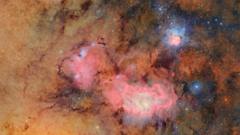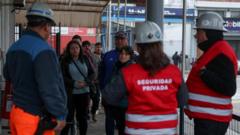*The Vera C. Rubin Observatory has released its first stunning images, showcasing cosmic phenomena and heralding advancements in astrophysics as it embarks on a decade-long mission of exploration and discovery.*
**First Light: The Vera Rubin Telescope's Inception Marks a New Era in Astronomy**

**First Light: The Vera Rubin Telescope's Inception Marks a New Era in Astronomy**
*A groundbreaking telescope in Chile reveals its inaugural celestial images, promising unprecedented insights into the universe.*
The Vera C. Rubin Observatory in Chile has made an impressive debut by unveiling its first images, signaling a remarkable leap forward in astronomical observation. The striking photographs reveal the Trifid and Lagoon nebulae, vibrant with colorful gas and dust clouds that are located 9,000 light-years away from our planet. This state-of-the-art telescope, equipped with the world's most powerful digital camera, is poised to reshape our understanding of the cosmos.
The Rubin Observatory aims to enhance our knowledge of the universe by possibly locating a ninth planet within our solar system, identifying near-Earth asteroids, and mapping the Milky Way. Furthermore, it will address critical questions surrounding dark matter—the enigmatic substance comprising a major portion of the universe. After decades of anticipation, Professor Catherine Heymans, Scotland's Astronomer Royal, shared her excitement for this momentous occasion by stating she has been striving for 25 years to realize this vision.
The UK plays a significant role in this endeavor, with data centers being established to process the high-fidelity images captured as the telescope diligently surveys the skies. Experts predict that the observatory could potentially uncover ten times the number of known celestial objects in our solar system. During a recent tour of the facility, BBC News learned about the observatory's strategic location on Cerro Pachón in the Chilean Andes, where the exceptional altitude, dry atmosphere, and darkness yield optimal stargazing conditions.
Necessary measures, such as limiting light pollution from within the observatory, ensure that the darkness is preserved, maximizing the quality of the celestial images obtained. According to commissioning scientist Elana Urbach, one of the observatory's primary ambitions is to understand the universe's history, which necessitates capturing observations of faint galaxies and supernovae from billions of years ago. The observatory's intricate design reflects this commitment to precision.
The telescope's advanced 3,200-megapixel camera, the result of collaboration between the US Department of Energy's SLAC National Accelerator Laboratory, utilizes a unique three-mirror system to achieve its remarkable imaging capabilities. With the potential to capture images every 40 seconds over an 8-12 hour period each night for a decade, it offers a comprehensive survey of the night sky.
Excitement pulses through the astronomical community as scientists prepare to sift through the anticipated flood of data—roughly 10 million alerts each night. The Vera Rubin Observatory will focus on four primary areas: detecting transient objects, detailing the formation of the Milky Way, mapping the Solar System, and examining dark matter to understand the creation of the universe. What sets this telescope apart is its capacity for continuous observation, allowing it to detect even the slightest changes over time.
The ability to spot transient celestial events holds immense promise, as it may uncover unknown phenomena previously unimagined. Moreover, the observatory's adeptness at pinpointing potentially hazardous objects near our planet, including asteroids like YR4, underscores its role in planetary defense.
As researchers look forward to analyzing data on star distribution within the Milky Way, Professor Alis Deason anticipates breakthroughs in exploring previously unreachable areas, potentially extending observations to 1.2 million light-years. The quest also involves unraveling the mystery surrounding the hypothetical Planet Nine, estimated to lie far beyond the boundaries of current instruments.
While the journey to fully comprehend the capabilities of the Vera Rubin Observatory will take time, the excitement and readiness to embrace this opportunity are palpable among astronomers. “This new beautiful observatory is set to usher in a transformative era in our understanding of the universe,” concludes Professor Heymans.
The Rubin Observatory aims to enhance our knowledge of the universe by possibly locating a ninth planet within our solar system, identifying near-Earth asteroids, and mapping the Milky Way. Furthermore, it will address critical questions surrounding dark matter—the enigmatic substance comprising a major portion of the universe. After decades of anticipation, Professor Catherine Heymans, Scotland's Astronomer Royal, shared her excitement for this momentous occasion by stating she has been striving for 25 years to realize this vision.
The UK plays a significant role in this endeavor, with data centers being established to process the high-fidelity images captured as the telescope diligently surveys the skies. Experts predict that the observatory could potentially uncover ten times the number of known celestial objects in our solar system. During a recent tour of the facility, BBC News learned about the observatory's strategic location on Cerro Pachón in the Chilean Andes, where the exceptional altitude, dry atmosphere, and darkness yield optimal stargazing conditions.
Necessary measures, such as limiting light pollution from within the observatory, ensure that the darkness is preserved, maximizing the quality of the celestial images obtained. According to commissioning scientist Elana Urbach, one of the observatory's primary ambitions is to understand the universe's history, which necessitates capturing observations of faint galaxies and supernovae from billions of years ago. The observatory's intricate design reflects this commitment to precision.
The telescope's advanced 3,200-megapixel camera, the result of collaboration between the US Department of Energy's SLAC National Accelerator Laboratory, utilizes a unique three-mirror system to achieve its remarkable imaging capabilities. With the potential to capture images every 40 seconds over an 8-12 hour period each night for a decade, it offers a comprehensive survey of the night sky.
Excitement pulses through the astronomical community as scientists prepare to sift through the anticipated flood of data—roughly 10 million alerts each night. The Vera Rubin Observatory will focus on four primary areas: detecting transient objects, detailing the formation of the Milky Way, mapping the Solar System, and examining dark matter to understand the creation of the universe. What sets this telescope apart is its capacity for continuous observation, allowing it to detect even the slightest changes over time.
The ability to spot transient celestial events holds immense promise, as it may uncover unknown phenomena previously unimagined. Moreover, the observatory's adeptness at pinpointing potentially hazardous objects near our planet, including asteroids like YR4, underscores its role in planetary defense.
As researchers look forward to analyzing data on star distribution within the Milky Way, Professor Alis Deason anticipates breakthroughs in exploring previously unreachable areas, potentially extending observations to 1.2 million light-years. The quest also involves unraveling the mystery surrounding the hypothetical Planet Nine, estimated to lie far beyond the boundaries of current instruments.
While the journey to fully comprehend the capabilities of the Vera Rubin Observatory will take time, the excitement and readiness to embrace this opportunity are palpable among astronomers. “This new beautiful observatory is set to usher in a transformative era in our understanding of the universe,” concludes Professor Heymans.
















